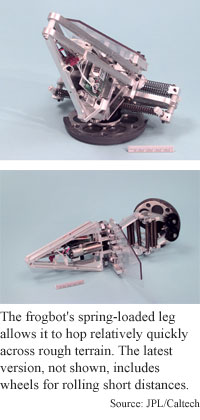
Exploratory robot hops and rolls
By Ted Smalley Bowen, Technology Research NewsGetting from point A to point B in the exploration of extraterrestrial terrain is fraught with uncertainty. With that in mind, researchers at NASA’s Jet Propulsion Laboratory and the California Institute of Technology have developed a robot capable of both hopping and rolling.
Such robots could be used independently or with larger rover units to map and gather samples from planets or other celestial bodies.
The researchers’ third generation frogbot has wheels in addition to its precursor's spring-loaded leg. It can hop to span distances or clear obstacles and roll to reach specific targets.
“It has some wheels on board so that once it hops and lands and crashes and picks itself up, it can locally drive around and almost be like a little miniature rover,” said Joel Burdick, a researcher at Caltech’s Center for Neuromorphic Systems Engineering.
The hurdles presented by navigating remote and unpredictable terrain compound the normal variables facing robot designers, said Paolo Fiorini, a robotics engineer at the Jet Propulsion Laboratory.
“Robotics has always been dealing with uncertainty, but usually it’s a very small uncertainty, like you’re trying to put a peg in a hole, and perhaps you’re missing a little bit, so you put some trick to simplify the problem. But it’s some sort of linearization in the neighborhood of your solution. Here, we can have very large uncertainties, so how do we deal with that?”
The roughly 1-kilogram robot uses two or more computer processors and a mechanical timing logic unit to control its functions. It packs a color camera, two dual-axis accelerometers to determine its orientation, and a radio-frequency modem for remote communication.
The designers have also opened up control of the unit’s hopping angle, making it possible to adjust the trajectory of its flight. The hopping angle is the angle between the trajectory tangent and the ground, Burdick explained.
“We’re able to adjust the hopping angle so we can hop with a very high arc or hop with a very shallow arc, so we can either go out far, or we may want to go high, over a very big obstacle. Or, we can actually shoot ourselves straight up and take a panoramic camera view,” he said.
The robot’s hopping range is about 1.8 meters in Earth gravity, or about six meters on a low-gravity body like Mars.
There are two ways to design hopping mechanisms, according to Ben Brown, a project scientist at Carnegie Mellon University.
“One is something that sits there and stores up energy and launches itself, like the JPL scheme, and then there’s stuff that does more continuous hopping,” Brown said.
“The advantage of doing continuous hopping is that you can recover a lot of energy from one bounce to the next. Of course, one of the problems is that you have to control the attitude of the thing when it’s flying, so it comes down with the leg pointing down. You also probably have to worry more about what you land on.” CMU researchers are working on a continuous hopping mechanism.
The JPL/Caltech researchers are also contemplating a stripped-down version of their robot, according to Burdick. “Imagine you’ve got a bunch of buttons, which have a basic leg mechanism. You throw a thousand of these things out, and what they do is they hop around and position themselves, and once they get in place the locomotion systems dies, because it’s not meant to last a long time.”
When the robot stops, “it just sits there as a sensor. You can imagine putting on it seismic sensors, wind sensors, temperature sensors, basically geological types of sensors, so that you could distribute these things out in kind of a network and help to position them using some cheap, onboard locomotion system,” Burdick said.
While the project’s focus has been technology development in the service of space exploration, there could be terrestrial applications of the basic technology, according to Fiorini.
Such highly mobile robots could be used in search and rescue operations, as listening devices, or in agricultural tasks, such as the precise application of pesticides, he said.
If the technology is selected for use in space, the design will shift to accommodating the demands of space flight, including withstanding multiple g-forces, according to the researchers.
The project is roughly three to five years from producing a mission-ready robot, Fiorini said.
The researchers are testing the third generation frogbot, in anticipation of readying field-test prototypes. Burdick's and Fiorini's colleagues were Eric Hale and Nathan Schara of Caltech. They presented the work, through its second generation, at the 2000 IEEE International Conference on Robotoics and Automation in San Francisco in May.
The work is funded by NASA and the National Science Foundation.
Timeline: 3-5 years
Funding: Government
TRN Categories: Robotics
Story Type: News
Related Elements: Image; Technical paper, "A Minimally Actuated Hopping Rover for Exploration of Celestial Bodies," 2000 IEEE International Conference on Robotoics and Automation in San Francisco in May
Advertisements:
December 13, 2000
Page One
Nanotube fabric looms large
Silicon nanocrystals glow
Exploratory robot hops and rolls
Lasers flex gel muscles
Atomic scale wire speeds electrons

News:
Research News Roundup
Research Watch blog
Features:
View from the High Ground Q&A
How It Works
RSS Feeds:
News
Ad links:
Buy an ad link
| Advertisements:
|
 |
Ad links: Clear History
Buy an ad link
|
TRN
Newswire and Headline Feeds for Web sites
|
© Copyright Technology Research News, LLC 2000-2006. All rights reserved.